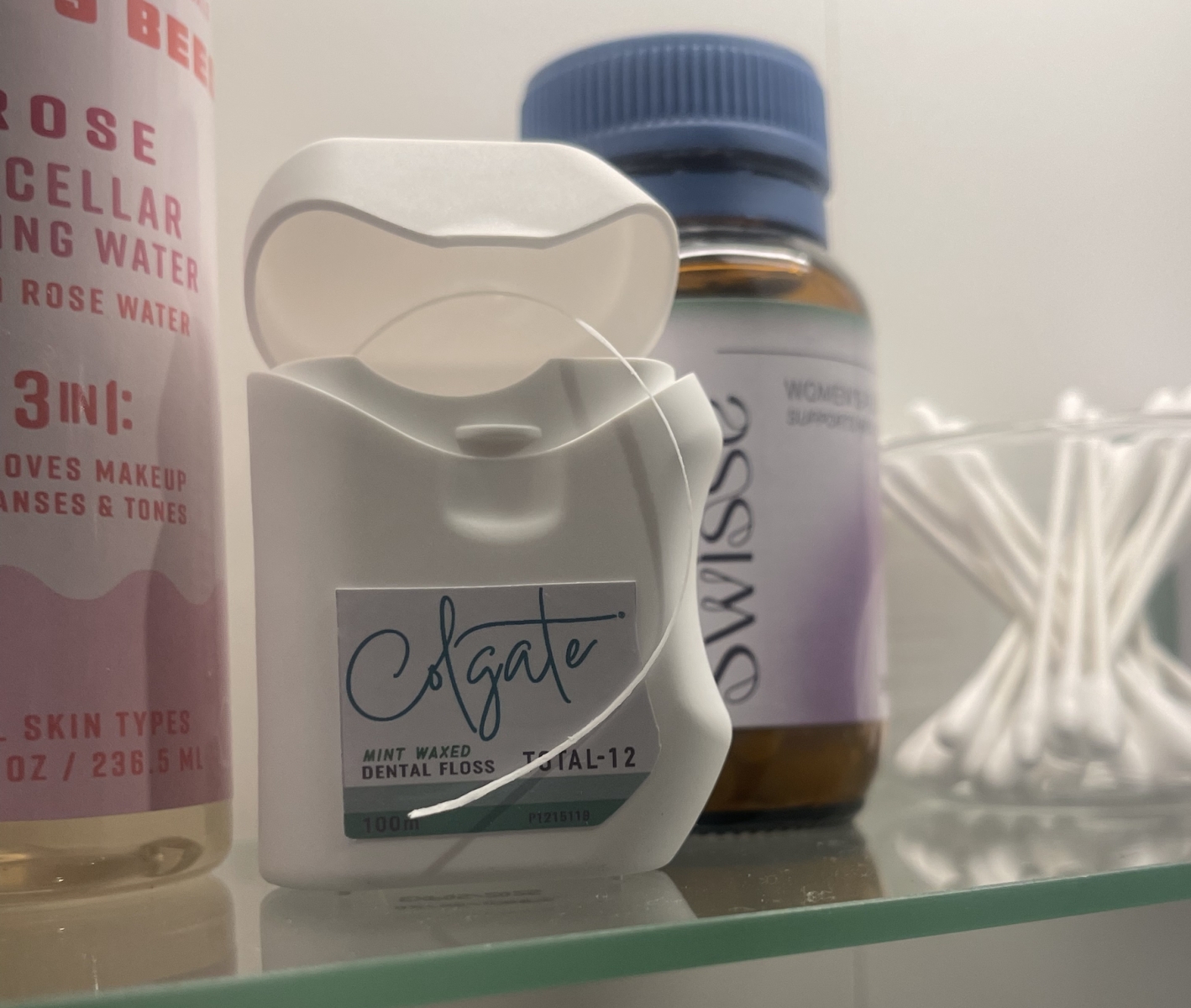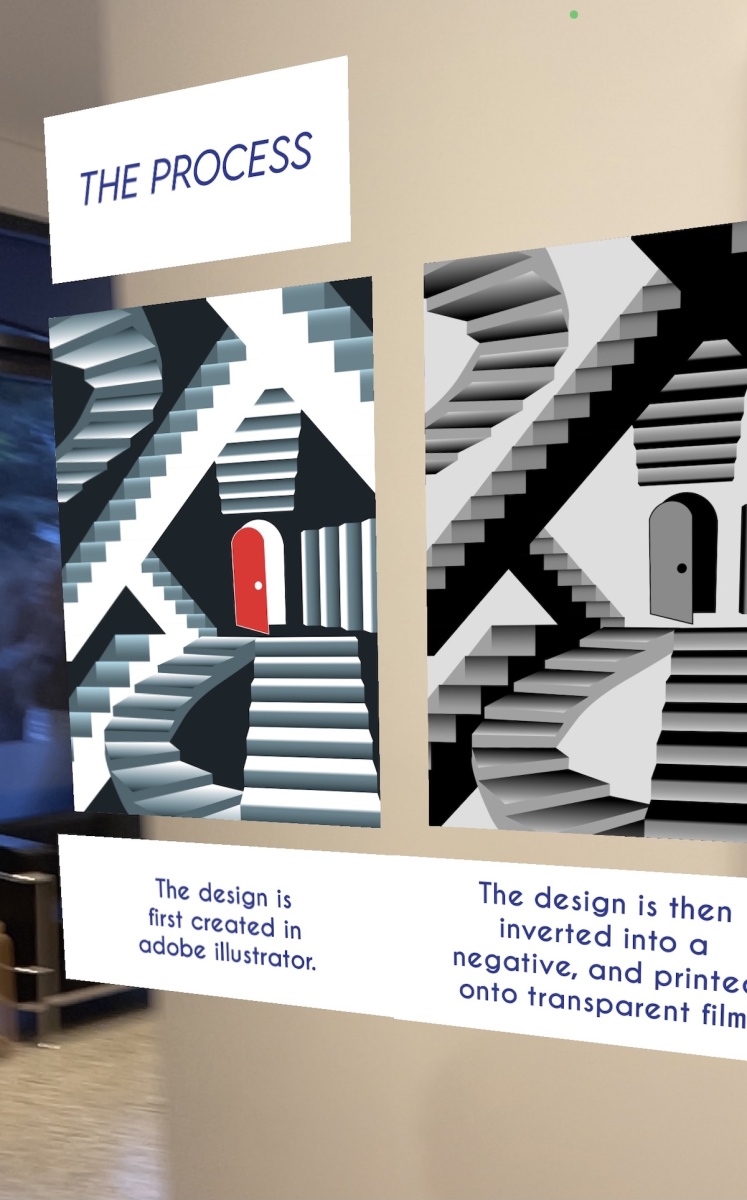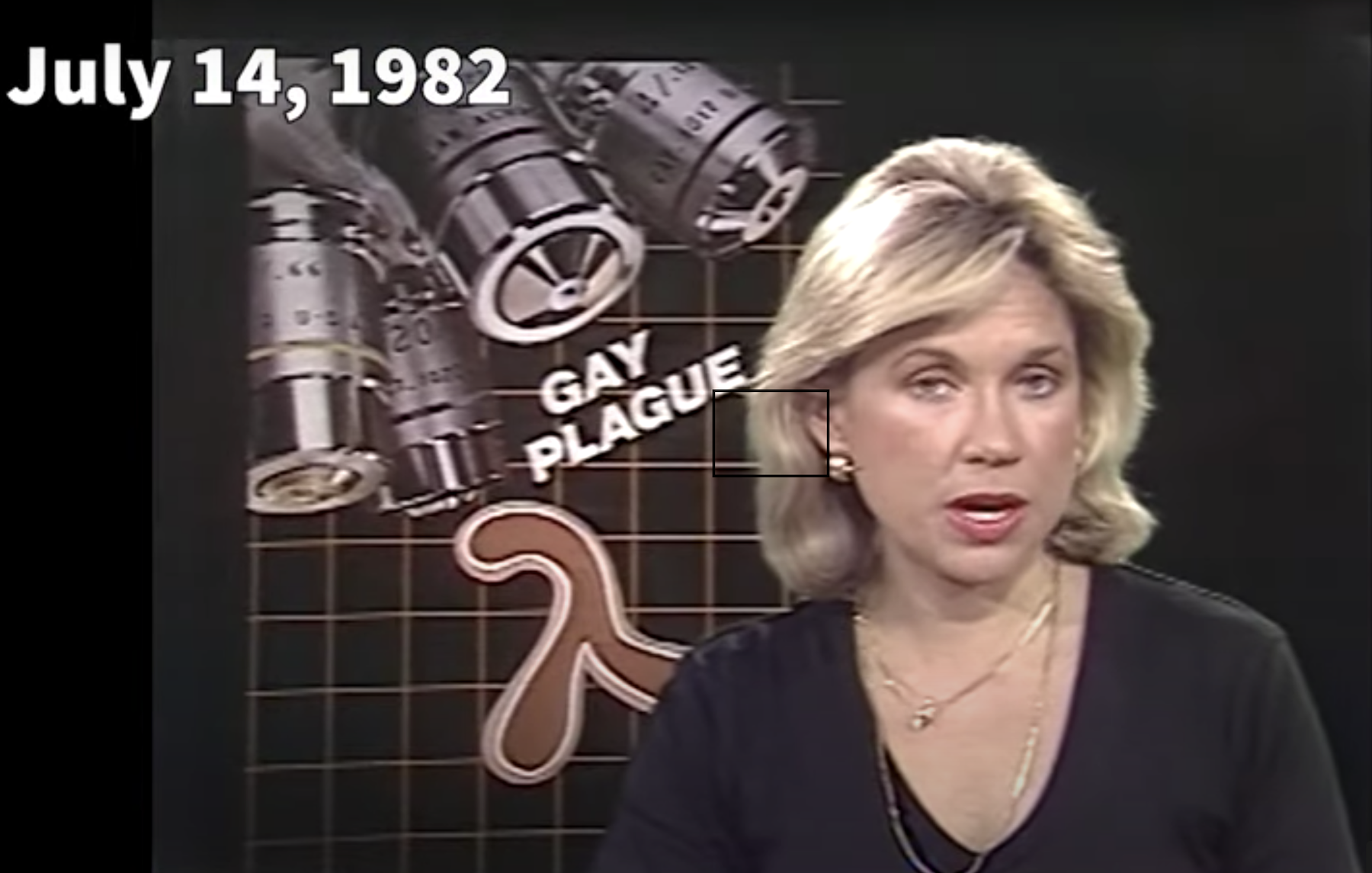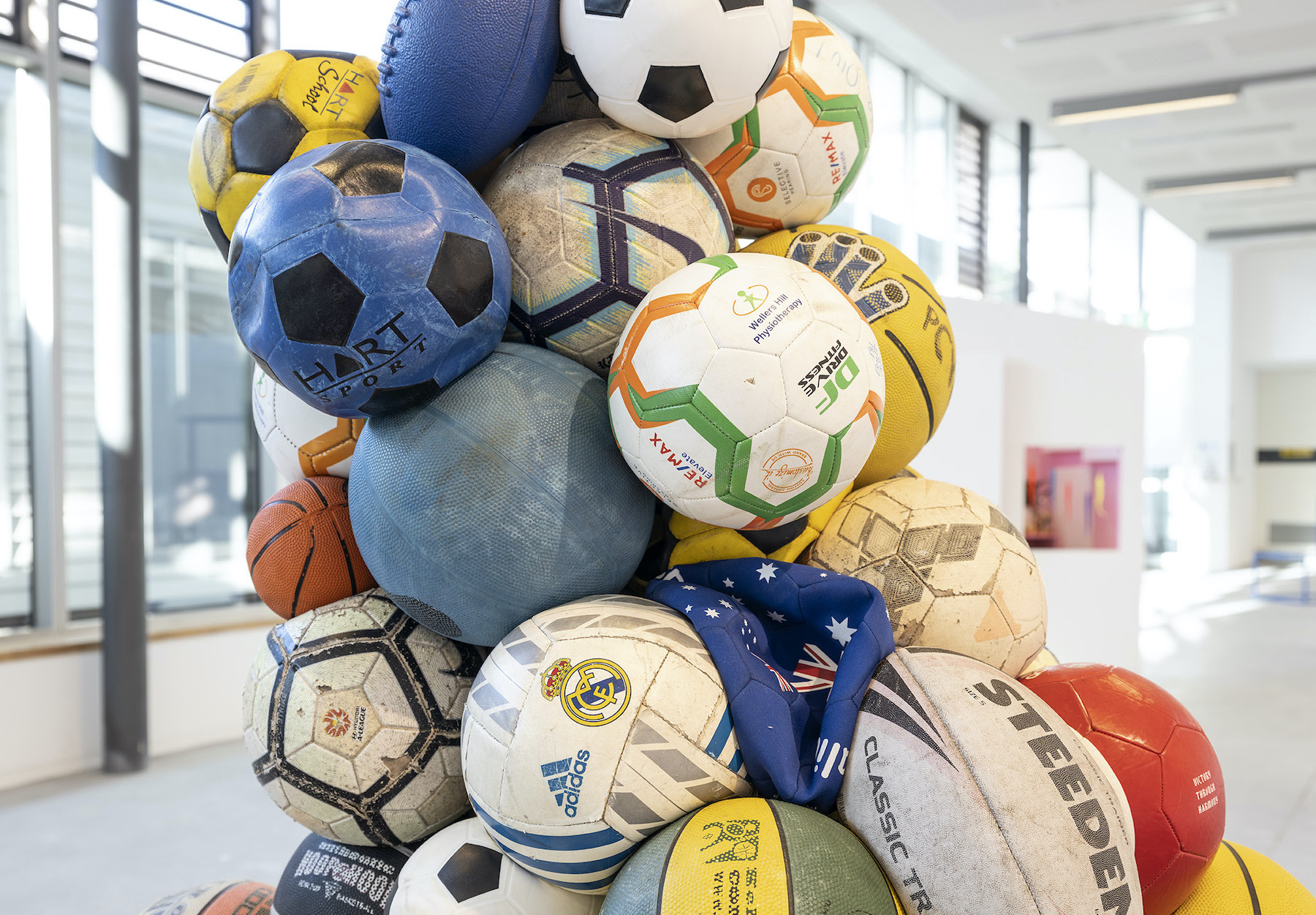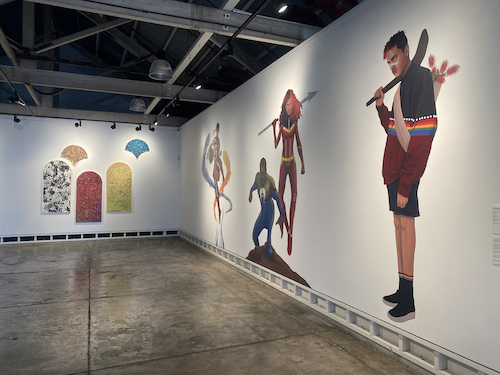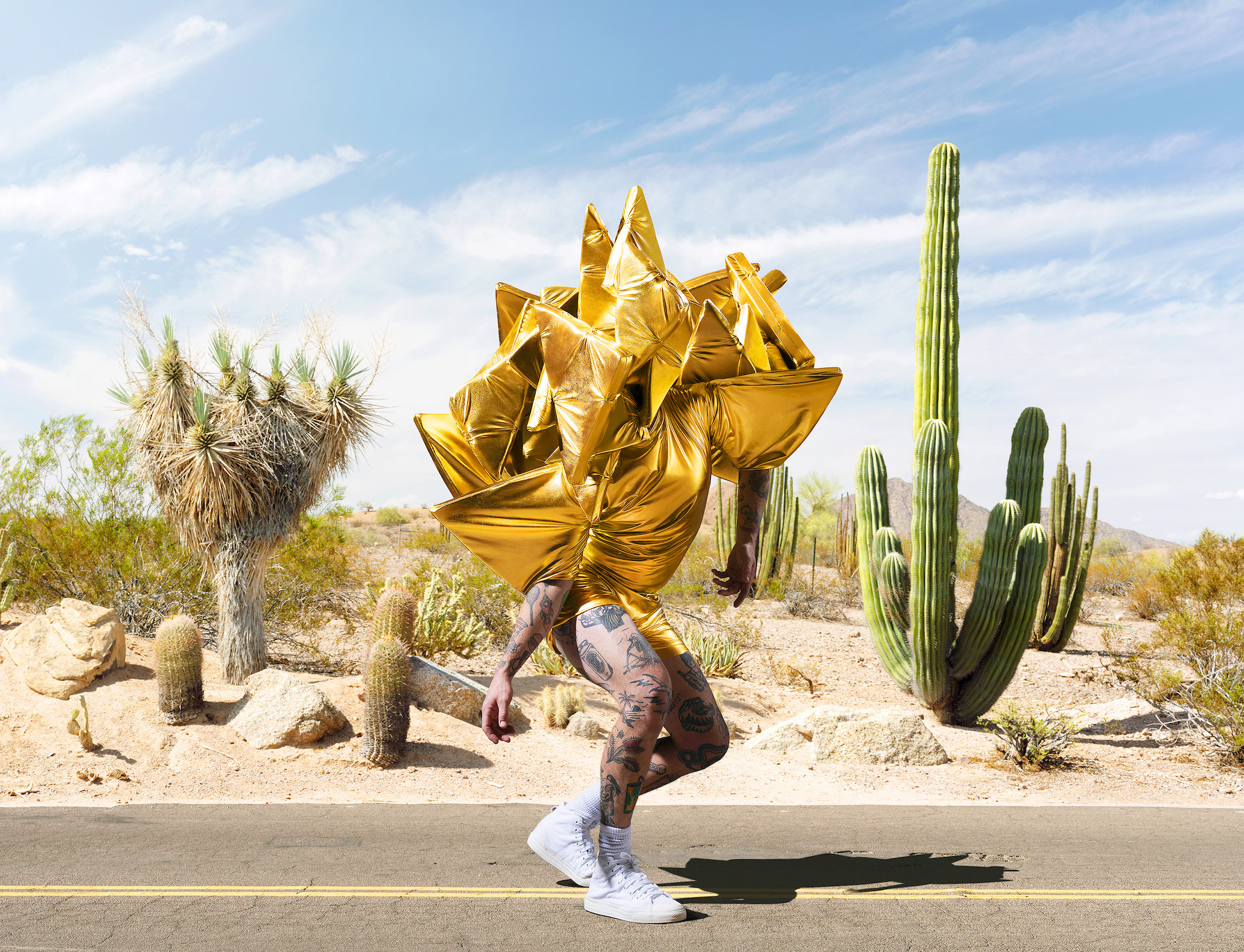Unlike Organisms | Deodorant, TVs, staircases, and quiet invitations.
Relationality is on the brain. Symbiosis—this exhibition’s title—is the close, living together of unlike organisms. Images of cows and white egrets roaming paddocks by the highway come to mind. But the exhibition pamphlet tells me it’s more about the relationship between design and the world we live in. Whilst symbiosis is often assumed to refer to mutually beneficial coexistence, there are another two subcategories: parasitic and commensal. The three dynamics are categorised by the presence of benefit or harm, or whether a party remains unaffected. There’s a directionality and transactionality that runs through this idea of symbiosis. Immediately, it has me thinking about the relationship between institution and artist, exhibition and patron, and culture and community. How do you prepare students for this industry whilst also offering them ways to create art and design experiences that aren’t just anchored in linearity, survivalism, and commerce?
USC’s Design program focuses on interdisciplinary practices and the ways in which different forms and methodologies encounter one another and are changed because of it. This year’s cohort of 50 graduating students present projection, augmented reality design, photography, illustration, interactive media, sound design, and games. Distinct from most graduate art shows, a significant number of the students specialize in visual communication, marketing, and interactive UX design.
Within the graduate exhibition, walls are lined with very orderly square grids and product displays. The burden of design is heavy in the room: cleanliness, legibility, and information deliverance are strong guiding principles. Aesthetics drive a lot of the presentations but an awareness of function, of what works do is also really present. Curatorially, this influence means that even the more experiential works, like the animations, screen media, game design, photography, and illustration, feel framed by an imperative to describe, communicate, and get visitors to interact in a somewhat prescriptive way.
A highlight is Visual Communication student, Millie Robson’s, Perceptions. This floating bathroom vanity cupboard is filled with subtly redesigned labels on familiar home bathroom products. The redesigns are mostly just font and format changes, but the effect is substantial. Robson dislodges products like Dove deodorant, Listerine mouthwash, and Colgate floss from their capital identity and iconography. Their ‘thingness’ is suddenly very palpable. The ideological remedies that branding becomes metaphors for—beauty, sustainable consumption, agelessness—is undermined. There’s a suggestive nudge toward Duchamp’s Fountain (1917) via using found object as art material and intersecting bathroom and gallery contexts to illustrate institutional mirage. Beyond this though, Robson also manages to work with found objects in a way that ‘un-found’s them. This is estrangement as reinvention. I wonder if anyone will use the cotton tips to clean their ears after the exhibition is over.
I’m also drawn to a circa ‘94 AKAI TV with channel and volume push buttons on the front on a white plinth. I can’t quite hear the sound, so I get close. I’m short, so there’s a slight crane in the way I look up to the images. It feels appropriate. I would have been about 3 years old when this TV came out. The work is Nostalgia by Screen Media student Bronson Mitchells.
In a subversive salute to The Good Ol’ Days ™, Mitchells splices together Anglo-American and Anglo-Australian archival media coverage of eight significant and violent events between the late 1950s and early 2000s. Nostalgia playfully mocks the tendency to romanticize the past but there’s a certain dramaturgical looseness to the selection of clips. A deeper, more poignant authorial stance is almost on the verge of being realised. Artists like Kasumi, Soda_Jerk, or even local artist Amanda Bennett’s QCA 2022 graduate work have contributed to a set of expectations of the genre. I find myself wanting more.
Nostalgia is capstoned by an animation of a fuchsia 80s retro-futuristic MTV sunset, a lineated fixed setting sun against an endless dark sky. Rolling pop synthwave topographies pulse either side of a long stretching path. This cross-section of spindly low-polygon meshes evaporates into dense passing clouds, creating the impression of traveling down a long road in the night. Despite the implication of the great terrains traversed by the viewer, the sun remains unsetting. It is the animation that most strongly proposes a conceptual anchor; whilst the work is seemingly ‘historic,’ Australia remains stuck traversing the same political territories of these by-gone eras. The Voice referendum, Federal support of genocidal warfare in Palestine under the pretense of terrorist retaliation, and the role that transphobia plays in preventing queer communities from accessing proper healthcare, are all symptoms of a cultural deja vu that indicate that the attitudes from Nostalgia remain current and unresolved.
Notions of progression also underpin Visual Design student, Jolie Gibbs’, Ascend, as she considers multiple pathways to new opportunities. Ascend is a cyanotype of geometrically distorted, illusionary winding stairs, each with different gravity centers akin to MC Escher’s Relativity (1953). However, with the use of Eye Jack (an augmented reality app), the depicted pathways are multiplied again to describe her artistic steps. In a virtual layer over the framed cyanotype, there are photographs and written descriptions of the original digital design, its inversion into a negative, a transparent film print, the cyanotype application, and the final sun-developing process. This Eye Jack integration offers generous artistic insights and a potential strategy for galleries to provide accessible context to works. At the heart of the work sits the question: how do artists provide multiple ways for others to access their work and yet not fall captive to the impulse to reductively over-explain artistic intention?
A good quarter of the exhibition uses either Eye Jack or augmented reality design. That’s a lot of virtual realities layered on top of lived experiences and designs to transport patrons elsewhere. And consequently it’s such a tender and moving experience to stumble on a thin gray notebook on a shelf. It goes unnoticed by many. Its invitation is quiet. Inside on the thin pages are a collection of stonewashed-denim-blue pencil illustrations. The illustrations are of entangled creatures, quotidian slumped and laced boots discarded but tied together, dogs chasing each others’ tails, mutated and conjoined baby lambs surrounded by oversized feathery moths. Audiences are invited to literally hold the softness, poetic brutality, and sense of displacement of this work in their hands. It is this part of Animation student, Wesley Carlyon’s, What Time Is It In Chicago, Illinois? that is so beautiful. I know that beautiful is a dirty word in art criticism, but that’s what it is. It is these sketches of relationality and the simplicity of the analogue design that most powerfully encapsulates the potency of encounter between artist, art, and viewer.
Expanded Lemonade coverage of 2023 graduate exhibitions was kindly made possible by Lemonade’s Patreons and generous contributions from Alex Baxter, Amanda Bennetts, Kylie Harries, Lynn Hughes, Kit Kriewaldt, Pippa Macgill, Merilyn & Steve Mayhew, JM Orme, Alethea Richter, Monica Rohan, Adrian Smith, Gavin Smith, Leisa Turner, Hannah Williamson, Nadya Wilson.
Lemonade is continuing to fundraise for three further reviews. Become a Patreon or email editor @ lemonadeletters.com.au to support this unique coverage of emerging artists.
Ruby Donohoe is an interdisciplinary artist based on Kabi Kabi Country (Sunshine Coast) whose works are rooted in the politics of encounter and draw on expanded choreographic practices, participatory performance, installation, and video. Ruby is a founding co-director of IN | artist run initiative at The Old Lock Up (2021 – now) and OUTBOUND | Contemporary Dance x Live Art Festival (launched in 2023).


